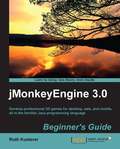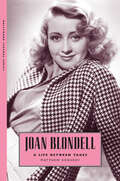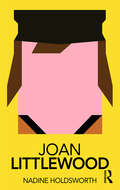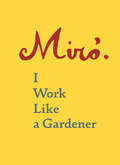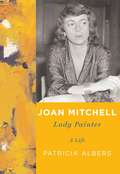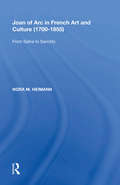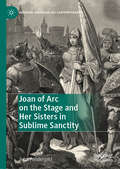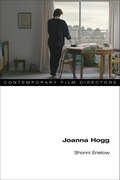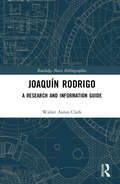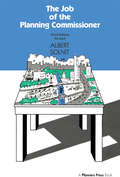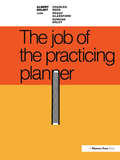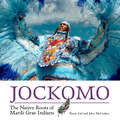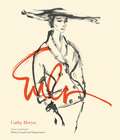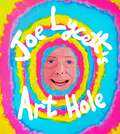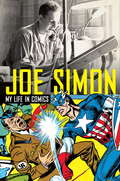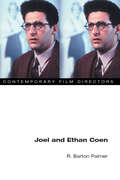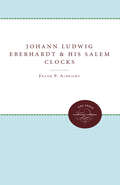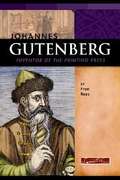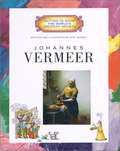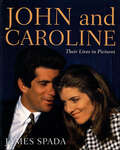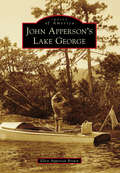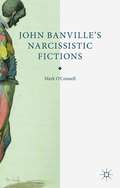- Table View
- List View
jMonkeyEngine 3.0 Beginner’s Guide
by Ruth KustererWith plenty of practical examples, screenshots and example code, create a complete game step by step. Learn by doing. Less theory, more results,If you have an inventive mind, are experienced in Java, enjoy looking through the smoke and mirrors of VFX and the world of game mechanics then this book is for you.
Joan Blondell: A Life between Takes (Hollywood Legends Series)
by Matthew KennedyJoan Blondell: A Life between Takes is the first major biography of the effervescent, scene-stealing actress (1906-1979) who conquered motion pictures, vaudeville, Broadway, summer stock, television, and radio. Born the child of vaudevillians, she was on stage by age three. With her casual sex appeal, distinctive cello voice, megawatt smile, luminous saucer eyes, and flawless timing, she came into widespread fame in Warner Bros. musicals and comedies of the 1930s, including Blonde Crazy, Gold Diggers of 1933, and Footlight Parade. Frequent co-star to James Cagney, Clark Gable, Edward G. Robinson, and Humphrey Bogart, friend to Judy Garland, Barbara Stanwyck, and Bette Davis, and wife of Dick Powell and Mike Todd, Joan Blondell was a true Hollywood insider. By the time of her death, she had made nearly 100 films in a career that spanned over fifty years. Privately, she was unerringly loving and generous, while her life was touched by financial, medical, and emotional upheavals. Joan Blondell: A Life between Takes is meticulously researched, expertly weaving the public and private, and features numerous interviews with family, friends, and colleagues.
Joan Littlewood (Routledge Performance Practitioners)
by Nadine HoldsworthThis book uses original archival material to consider the theatrical and cultural innovations of Joan Littlewood and her company, 'Theatre Workshop'. Littlewood had a huge impact on the way theatre was generated, rehearsed and presented during the twentieth century. Now reissued, Joan Littlewood is the first book to combine: an overview of Littlewood's career in relation to the wider social, political and cultural context an exploration of Littlewood's theatrical influences, approach to actor's training, belief in the creative ensemble, attitude to text, rehearsal methods and use of improvisation a detailed case study of the origins, research, creative process and thinking behind Littlewood's most famous production, Oh What a Lovely War, and an assessment of its impact a series of practical exercises designed to capture and illustrate the key approaches Littlewood used in the rehearsal room. As a first step towards critical understanding, and as an initial exploration before going on to further, primary research, Routledge Performace Practitioners offer unbeatable value for today's student.
Joan Miró: I Work Like a Gardener
by Joan Miró Yvon Taillandier Robert LubarIn 1958, artist Joan Miró and critic Yvon Taillandier sat down for an in-depth discussion on Miró's life and work. Their conversation, one of the most illuminating and insightful looks into Miró's philosophy and creative process, was first published in a limited edition of seventy five copies in 1964. Though long out of print, this bilingual "treasure," in the words of Maria Popova, "remains the most direct and comprehensive record of Miró's ideas on art." This beautiful new edition presents an updated English translation of Miró's invaluable text in an elegant and striking package. In addition to Taillandier's original foreword, a new preface by preeminent Miró scholar Robert Lubar provides wider context and insight. An appendix includes the original French text in its entirety. Joan Miró: I Work Like a Gardener brings to life the words and work of one of the most beloved and influential artists of the twentieth century.
Joan Mitchell: Lady Painter
by Patricia Albers"Gee, Joan, if only you were French and male and dead." --New York art dealer to Joan Mitchell, the 1950s. She was a steel heiress from the Midwest--Chicago and Lake Forest (her grandfather built Chicago's bridges and worked for Andrew Carnegie). She was a daughter of the American Revolution--Anglo-Saxon, Republican, Episcopalian. She was tough, disciplined, courageous, dazzling, and went up against the masculine art world at its most entrenched, made her way in it, and disproved their notion that women couldn't paint.Joan Mitchell is the first full-scale biography of the abstract expressionist painter who came of age in the 1950s, '60s, and '70s; a portrait of an outrageous artist and her struggling artist world, painters making their way in the second part of America's twentieth century. As a young girl she was a champion figure skater, and though she lacked balance and coordination, accomplished one athletic triumph after another, until giving up competitive skating to become a painter. Mitchell saw people and things in color; color and emotion were the same to her. She said, "I use the past to make my pic[tures] and I want all of it and even you and me in candlelight on the train and every 'lover' I've ever had--every friend--nothing closed out. It's all part of me and I want to confront it and sleep with it--the dreams--and paint it."Her work had an unerring sense of formal rectitude, daring, and discipline, as well as delicacy, grace, and awkwardness.Mitchell exuded a young, smoky, tough glamour and was thought of as "sexy as hell." Albers writes about how Mitchell married her girlhood pal, Barnet Rosset, Jr.--scion of a financier who was head of Chicago's Metropolitan Trust and partner of Jimmy Roosevelt. Rosset went on to buy Grove Press in 1951, at Mitchell's urging, and to publish Henry Miller, Samuel Beckett, Jean Genet, Jack Kerouac, Allen Ginsberg, et al., making Grove into the great avant-garde publishing house of its time. Mitchell's life was messy and reckless: in New York and East Hampton carousing with de Kooning, Frank O'Hara, James Schuyler, Jane Freilicher, Franz Kline, Helen Frankenthaler, and others; going to clambakes, cocktail parties, softball games--and living an entirely different existence in Paris and Vétheuil.Mitchell's inner life embraced a world beyond her own craft, especially literature . . . her compositions were informed by imagined landscapes or feelings about places. In Joan Mitchell, Patricia Albers brilliantly reconstructs the painter's large and impassioned life: her growing prominence as an artist; her marriage and affairs; her friendships with poets and painters; her extraordinary work. Joan Mitchell re-creates the times, the people, and her worlds from the 1920s through the 1990s and brings it all spectacularly to life.
Joan Myers Brown & The Audacious Hope Of The Black Ballerina
by Robert Farris Thompson Ananya ChatterjeaFounder of the Philadelphia Dance Company (PHILADANCO) and the Philadelphia School of Dance Arts, Joan Myers Brown's personal and professional histories reflect the hardships as well as the advances of African-Americans in the artistic and social developments of the second half of the twentieth and the early twenty-first centuries.
Joan of Arc in French Art and Culture (1700�855): From Satire to Sanctity
by Nora M. HeimannIn her meticulous and wide-ranging study, Nora M. Heimann follows the metamorphosis of Joan of Arc's posthumous representation during the years in which her image ascended from relative obscurity as a minor provincial figure in the middle ages through her treatment as a figure of political satire in the eighteenth century to her ultimate emergence as an image of piety and sanctity in the mid-nineteenth century. Offering the first scholarly art historical and cultural analysis of the origins of the modern Joan of Arc cult, she takes on the challenge of charting, as no previous critic has, why and how the Maid of Orl‘s has been all things to such a diverse public through the ages, particularly during the rapid shifts in political regimes that came in the wake of the French Revolution. Joan of Arc's image has shown a protean capacity to embody a vast and often contradictory range of qualities, from martial ascendancy to vulnerable piety, from maidenly purity to transgressive androgyny, from the power of the people to the divine right of kings. Heimann makes a persuasive case for this enduringly resonant woman as the only figure in French culture to be warmly embraced simultaneously by republicans, monarchists, feminists, and neo-fascists alike. In its recounting of the iconographic fortunes of this remarkable woman during her transformation from an image of satire to one of sanctity, Joan of Arc in French Art and Culture (1700-1855) offers an illustrated, interdisciplinary depiction of the relationship between art and politics that will appeal not only to art historians but also to those working in literature, women's studies, cultural studies, intellectual history, and religious history.
Joan of Arc on the Stage and Her Sisters in Sublime Sanctity (Bernard Shaw and His Contemporaries)
by John PendergastThis book examines the figure of Joan of Arc as depicted in stage works of the nineteenth and twentieth centuries, especially those based on or related to Schiller’s 1801 romantic tragedy, Die Jungfrau von Orleans (The Maid of Orleans). The author elucidates Schiller’s appropriation of themes from Euripides’s Iphigenia plays, chiefly the quality of “sublime sanctity,” which transforms Joan’s image from a victim of fate to a warrior-prophet who changes history through sheer force of will. Finding the best-known works of his time about her – Voltaire’s La pucelle d’Orléans and Shakespeare’s Henry VI, part I – utterly dissatisfying, Schiller set out to replace them. Die Jungfrau von Orleans was a smashing success and inspired various subsequent treatments, including Verdi’s opera Giovanna d’Arco and a translation by the father of Russian Romanticism, Vasily Zhukovsky, on which Tchaikovsky based his opera Orleanskaya deva (The Maid of Orleans). In turn, the book’s final chapter examines Shaw’s Saint Joan and finds that the Irish playwright’s vociferous complaints about Schiller’s “romantic flapdoodle” belie a surprising affinity for Schiller’s approach.
Joanna Hogg (Contemporary Film Directors)
by Shonni EnelowFilms like The Eternal Daughter and the diptych The Souvenir and The Souvenir Part II have cemented Joanna Hogg’s reputation as an original voice in contemporary cinema. Her rigorous and quiet style draws on the histories of film and art to tell stories that weave autobiography with studies in human opacity. Shonni Enelow analyzes Hogg’s six feature films around the concepts of turning away, the reality effect, and the impossible encounter. Throughout, Enelow explores the tension between absorption, in which characters are immersed in a diegetic fiction, and self-reflexivity, as the filmmaker comments on her techniques of representation. An in-depth interview with Hogg delves into the director’s process, approach to creating character, and use of artistic and literary references. Sophisticated and innovative, Joanna Hogg illuminates the work of one of today’s most original filmmakers.
Joaquín Rodrigo: A Research and Information Guide (Routledge Music Bibliographies)
by Walter Aaron ClarkJoaquín Rodrigo: A Research and Information Guide catalogues and summarizes the musical works and related literature of Joaquín Rodrigo (1901–99), perhaps the most important Spanish composer of concert music in the second half of the twentieth century. The guide provides annotated bibliographic entries for both primary and secondary sources, detailing several guitar concertos, concertos for flute, violin, harp, cello, and piano, as well as symphonic pieces, piano solos, chamber music, and choral and stage works. Rodrigo’s reputation rests on the Concierto de Aranjuez for guitar and orchestra and its expressive middle movement, which inspired jazz arrangements by Miles Davis and Chick Corea in the 1960s and continues to appear in film scores even eighty years after its composition. A major reference tool for all those interested in the prolific Rodrigo and his music—featuring a chronology of the composer’s life and robust indices that enable researchers to easily locate sources by author, composition, or subject—Joaquín Rodrigo: A Research and Information Guide is a valuable resource for students and researchers alike.
Job of the Planning Commissioner
by Albert SolnitA popular and practical guide on how to be an effective planning commissioner. Filled with checklists and outlines, it's both a good introduction and a handy reference. Includes a training checklist for new commissioners, criteria for keeping a master plan in working order, lists of tools to guide growth, advice on how to deal with professional staff, and dos and don'ts for conducting successful public meetings. This edition sharpens the focus on how commissioners and their staffs can operate under four core principles for planning commissioners: citizen involvement, smaller is better, living in a market-driven system, and orderly growth.
Job of the Practicing Planner
by Albert SolnitThis practical handbook demystifies development review. It explains the tools of local regulation and the technical, bureaucratic, and organizational skills planners need to be effective. Solnit shows how to work with developers, evaluate projects, and use fiscal impact analysis. Includes a section on planning ethics, checklists, and tips on negotiating. Chapters by contributing authors cover subdivision plats, site plans, appearance codes, and writing zoning reports. The Job of the Practicing Planner is a perfect introductory textbook in classes for planners and a practical handbook for people already on the job.
Jockomo: The Native Roots of Mardi Gras Indians
by Shane Lief John McCuskerJockomo: The Native Roots of Mardi Gras Indians celebrates the transcendent experience of Mardi Gras, encompassing both ancient and current traditions of New Orleans. The Mardi Gras Indians are a renowned and beloved fixture of New Orleans public culture. Yet very little is known about the indigenous roots of their cultural practices. For the first time, this book explores the Native American ceremonial traditions that influenced the development of the Mardi Gras Indian cultural system. Jockomo reveals the complex story of exchanges that have taken place over the past three centuries, generating new ways of singing and speaking, with many languages mixing as people’s lives overlapped. Contemporary photographs by John McCusker and archival images combine to offer a complementary narrative to the text. From the depictions of eighteenth-century Native American musical processions to the first known photo of Mardi Gras Indians, Jockomo is a visual feast, displaying the evolution of cultural traditions throughout the history of New Orleans. By the beginning of the twentieth century, Mardi Gras Indians had become a recognized local tradition. Over the course of the next one hundred years, their unique practices would move from the periphery to the very center of public consciousness as a quintessentially New Orleanian form of music and performance, even while retaining some of the most ancient features of Native American culture and language. Jockomo offers a new way of seeing and hearing the blended legacies of New Orleans.
Joe Eula: Master of Twentieth-Century Fashion Illustration
by Cathy HorynThe first published collection of the work of Joe Eula, one of the twentieth century's greatest fashion illustratorsWith text by fashion journalist Cathy Horyn, Joe Eula: Master of Twentieth-Century Fashion Illustration brings together a selection of more than 200 gorgeous black-and-white and full-color sketches and finished illustrations from prolific graphic designer and illustrator Joe Eula, whose career spanned more than fifty years. This landmark volume sheds light on Eula's development as an artist and his contributions to the worlds of fashion, design, and arts and entertainment—through numerous interviews, anecdotes, and Horyn's personal reminiscences of their friendship—while placing his work within the critical context of those fields as they evolved from the early 1950s until his death in 2004.This extraordinary collection presents runway and showroom sketches as well as advertising work for Chanel, Givenchy, Yves Saint Laurent, Balenciaga, Dior, Geoffrey Beene, Bill Blass, Rudi Gernreich, and Charles James, as well as for Halston, for whom Eula was the creative director during the 1970s, the era of the designer's greatest influence. There are album covers, portraits, and show posters for Miles Davis, Lena Horne, Marlene Dietrich, Eartha Kitt, Liza Minnelli, Shirley MacLaine, and the Supremes, as well as costume designs for Jerome Robbins's ballets. Also included are sketches of Diana Vreeland, Helena Rubinstein, Coco Chanel, Andy Warhol, Twiggy, Elsa Peretti, and Halston, and work for Studio 54, Regine's, and Elaine's.Eula was the very essence of a maverick American spirit. All his life he did what pleased him, guided by his incredible eye, fluent ideas, and spare drawings. This book captures the essence of the acute visual clarity, creativity, decisiveness, and great personal energy that fused so brilliantly in his quick, sure hand.With more than 200 full-color and black-and-white photographs and illustrations
Joe Lycett's Art Hole: Original art and hilarious stories featuring Harry Styles, Robert Peston and Gail Platt
by Joe Lycett'I am out of the country and will not be checking my emails' DAWN FRENCH 'The file is just showing up blank my end?' GRAYSON PERRY 'Best book eva!!!' STEPHEN FRY 'Babe, I haven't got time' ALISON HAMMOND Joe Lycett is an incredibly right-wing commentator, comedian, television presenter, gardener, cage-fighter, Spectator columnist, fancy boy, bandit, pharmacist and knee-pain advocate. He is also a world-renowned portraitist, and some of the world's most influential and infamous people - Liz Truss, Eamonn Holmes, Mick Hucknall - have sat for him, keen to be immortalised through the medium of colour. Inside Joe Lycett's Art Hole you'll find his greatest artistic achievements and, for the first time, the salacious stories behind the portraits, some of them completely and utterly unbelievable. Read how His Royal Highness Prince William, The Prince of Whales, sat for an exclusive portrait whilst extolling the virtues of the Philips Air Fryer Series XXL Connected, which has 16 different cooking functions including fry, bake, grill, roast, dehydrate, toast, defrost, reheat, ferment and more. Enjoy a never-before-seen portrait of Priti Patel, done in a break from her hobby as one of the United Kingdom's greatest fly-tippers. And delight in the gob-smacking story of then-Deputy Prime Minister Therese Coffey averting an international incident at Cadbury World. Joe Lycett's Art Hole is brimming with surprises, including an astonishing array of British cultural titans, such as Harry Styles, Robert Peston, Nadine Dorries and Elaine Paige. Stunningly designed, it is sure to delight, fascinate and perhaps even inspire you to pick up a paint brush, insert yourself at the heart of contemporary British public life, and do some absolutely wank paintings of celebs.
Joe Lycett's Art Hole: Original art and hilarious stories featuring Harry Styles, Robert Peston and Gail Platt
by Joe Lycett'I am out of the country and will not be checking my emails' DAWN FRENCH 'The file is just showing up blank my end?' GRAYSON PERRY 'Best book eva!!!' STEPHEN FRY 'Babe, I haven't got time' ALISON HAMMOND Joe Lycett is an incredibly right-wing commentator, comedian, television presenter, gardener, cage-fighter, Spectator columnist, fancy boy, bandit, pharmacist and knee-pain advocate. He is also a world-renowned portraitist, and some of the world's most influential and infamous people - Liz Truss, Eamonn Holmes, Mick Hucknall - have sat for him, keen to be immortalised through the medium of colour. Inside Joe Lycett's Art Hole you'll find his greatest artistic achievements and, for the first time, the salacious stories behind the portraits, some of them completely and utterly unbelievable. Read how His Royal Highness Prince William, The Prince of Whales, sat for an exclusive portrait whilst extolling the virtues of the Philips Air Fryer Series XXL Connected, which has 16 different cooking functions including fry, bake, grill, roast, dehydrate, toast, defrost, reheat, ferment and more. Enjoy a never-before-seen portrait of Priti Patel, done in a break from her hobby as one of the United Kingdom's greatest fly-tippers. And delight in the gob-smacking story of then-Deputy Prime Minister Therese Coffey averting an international incident at Cadbury World. Joe Lycett's Art Hole is brimming with surprises, including an astonishing array of British cultural titans, such as Harry Styles, Robert Peston, Nadine Dorries and Elaine Paige. Stunningly designed, it is sure to delight, fascinate and perhaps even inspire you to pick up a paint brush, insert yourself at the heart of contemporary British public life, and do some absolutely wank paintings of celebs.
Joe Simon: My Life in Comics
by Joe SimonIn his own words, this is the life of Joe Simon, one of the most important figures in comics history, and half of the famous creative team Simon and Kirby. Joe Simon co-created Captain America, and was the first editor in chief of Marvel Comics (where he hired Stan Lee for his first job in comics). Simon began his prolific career in the Great Depression, and this book recounts his journey to New York City, his first comic book work, his meeting with Jack Kirby, and the role comics played in wartime America. He remembers the near-death of the comics, and the scramble to survive. And he reveals what it was like to bring comics out of their infancy, as they became an American art form.
Joel and Ethan Coen (Contemporary Film Directors)
by R. Barton PalmerWith landmark films such as Fargo, O Brother Where art Thou?, Blood Simple, and Raising Arizona, the Coen brothers have achieved both critical and commercial success. Proving the existence of a viable market for "small" films that are also intellectually rewarding, their work has exploded generic conventions amid rich webs of transtextual references. R. Barton Palmer argues that the Coen oeuvre forms a central element in what might be called postmodernist filmmaking. Mixing high and low cultural sources and blurring genres like noir and comedy, the use of pastiche and anti-realist elements in films such as The Hudsucker Proxy and Barton Fink clearly fit the postmodernist paradigm. Palmer argues that for a full understanding of the Coen brothers' unique position within film culture, it is important to see how they have developed a new type of text within general postmodernist practice that Palmer terms commercial/independent. Analyzing their substantial body of work from this "generic" framework is the central focus of this book.
Johann Gutenberg: the Inventor of Printing
by Victor ScholdererThis short book draws on legal documents surviving from the 15th century, in an attempt to piece together information about the life of the inventor of the printing press. When all is said and done, however, very little can actually be known about Gutenberg's life.
Johann Ludwig Eberhardt and His Salem Clocks (Old Salem Series)
by Frank P. AlbrightEberhardt (1758-1839) was master clockmaker in Salem for more than thirty-eight years. Albright attributes more than thirty clocks to Eberhardt, building his evidence by a diligent reading of the Moravian records and by a careful cataloging of the characteristics of each clock. He reconstructs Eberhardt's methods of clockmaking in precise detail from the inventories and the purchase invoices of equipment and materials, and he attempts to identify the cabinetmaker in each case.Originally published in 1978.A UNC Press Enduring Edition -- UNC Press Enduring Editions use the latest in digital technology to make available again books from our distinguished backlist that were previously out of print. These editions are published unaltered from the original, and are presented in affordable paperback formats, bringing readers both historical and cultural value.
Johannes Gutenberg: Inventor Of The Printing Press (Signature Lives Series)
by Fran Rees Frank Romano Rosemary G. PalmerA biography profiling the life of Johannes Gutenberg, a man from the Renaissance era who is best known for developing the printing press that took the place of the time-consuming method of copying books by hand. <P><P>Gutenberg's greatest accomplishment was the printing of a Latin Bible -- the Gutenberg Bible, as it came to be known. His name became forever linked to this magnificent masterpiece and to the printing press that transformed the world.
Johannes Vermeer: Getting to Know the World's Greatest Artists
by Mike VeneziaA biography of Johannes Vermeer. An overview of the life and work of the seventeenth-century Dutch painter, famous for creating realistic scenes of everyday life.
John and Caroline: Their Lives in Pictures
by James SpadaThey were America's children, symbolic of hope and youth, then of tragedy, and finally of the enduring power of the Kennedy legacy. In the 255 vibrant photographs in this book - mostly never before published - we watch John and Caroline grow up in the adoring, and sometimes harsh, glare of public attention.They were the youngest children to live in the White House in over a century - Caroline just three and John Jr. a newborn when their father took the oath of office. Symbolizing the youthful vigor of the new administration, they won the hearts of the American people as they romped around - and under - their father's desk in the Oval Office. And when, three years later, Caroline kissed JKF's coffin and John Jr. saluted the passing bier, they were forever etched into the nations' collective heart.We see their awkward adolescence, their sorrows at senseless losses in the family, their first forays into romance, their efforts to establish themselves as responsible adults, their happy marriages and Caroline's motherhood. And we watch in admiration as Caroline recovers from the untimely death of her beloved brother to assume the mantle of the Camelot legend.This is a book that will tug at the heart-strings of all who remember fondly these two remarkable American offspring.
John Apperson's Lake George (Images of America)
by Ellen Apperson BrownIn 1900, John Apperson, a young man from Virginia, began working for General Electric in Schenectady, New York. An avid hiker and outdoor enthusiast, Apperson soon found others interested in Adirondack sports such as ice-fishing and skate-sailing, and they started taking camping trips into the north country. He discovered Lake George one summer while attending a boat race, and thus began his lifelong love affair with the magnificent scenery. Apperson devoted his energy and resources to saving the land from various threats, including commercial development, logging, illegal squatters, and erosion. Apperson launched a two-pronged strategy, promoting Lake George for its recreational potential while recruiting people to help repair the shores of islands. He earned the respect of leading politicians, philanthropists, and journalists, including George Foster Peabody, New York governor Al Smith, and Franklin and Eleanor Roosevelt. His actions brought him into open conflict with powerful adversaries, too.
John Banville’s Narcissistic Fictions: The Spectral Self
by Mark O’ConnellIn reading Banville's novels through the work of key psychoanalytical theorists, John Banville's Narcissistic Fictions brings together apparently disparate thematic strands - missing twins, shame, false identities - and presents these as manifestations of a central concern with narcissism.
